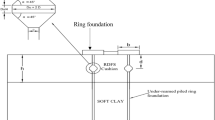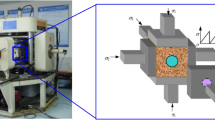Abstract
It is difficult to construct a conventional shallow foundation in alluvial lowlands because of soft soils and high ground water table. A rigid short caisson foundation with granular core is being proposed for alluvial lowlands. The proposed foundation is analyzed using non-linear hyperbolic stress–displacement responses of homogeneous alluvial deposits. Extensive parametric studies are carried out to study the effects of length ratio (L/d0), diameter ratio (d/d0) of granular core with respect to casing, relative stiffness of shaft (ατ), relative casing base stiffness (αb), and friction angle of granular material (ϕgp) on the load sharing and the settlement of the proposed foundation.




















Similar content being viewed by others
Abbreviations
- d:
-
Diameter of granular core/inner diameter of the well casing
- d0 :
-
Diameter (outer) of the well casing
- Dgp :
-
Constrained modulus of granular core
- Es :
-
Modulus of deformation of soil
- Egp :
-
Modulus of deformation of granular core
- K:
-
Coefficient of lateral pressure
- kgp :
-
Winkler’s subgrade reaction coefficient of granular core
- ksL :
-
Winkler’s subgrade reaction coefficient at base of granular core
- kst,s :
-
Winkler’s subgrade reaction coefficient of casing at surface of soil
- kst,b :
-
Winkler’s subgrade reaction coefficient at base of casing
- \(\left({\frac{\hbox{k}_{\rm sL}\hbox{d}}{\hbox{Q}_{\rm ult}}} \right)\) :
-
Non-linear bearing parameter
- \(\left({\frac{\hbox{k}_{\rm sL}\hbox{d}}{\tau_{\rm ult}}}\right)\) :
-
Non-linear shear parameter
- L:
-
Length of casing
- Q:
-
Load applied to composite foundation with granular core
- Qst :
-
Load taken (shared) by the well casing of composite foundation
- Qgp :
-
Load taken (shared) by the granular core of composite foundation
- qst :
-
Load intensity (stress) taken by the well casing of the composite foundation
- qgp :
-
Load intensity (stress) taken by the granular core of the composite foundation
- qst,s :
-
Load intensity (stress) taken by the casing (surface) of the composite foundation
- qst,b :
-
Load intensity (stress) taken by the casing (base) of the composite foundation
- qgp,s :
-
Load intensity (stress) taken by the granular core (surface) of the composite foundation
- qgp,b :
-
Load intensity (stress) at the granular core (base) of the composite foundation
- qult :
-
Ultimate bearing capacity of composite foundation with granular core
- R:
-
Relative granular core stiffness
- Rgp :
-
Constant
- wst :
-
Displacement of the casing relative to soil
- wsL :
-
Displacement of the granular core at base
- αb :
-
Relative casing base stiffness
- ατ :
-
Relative stiffness of shaft
- If :
-
Settlement influence factor
- τgp :
-
Shearing stress on the surface of the granular core
- τi :
-
Shearing stress on the inner surface of the casing
- τo :
-
Shearing stress on the outer surface of the casing
- νs :
-
Poisson’s ratio of soil
- νgp :
-
Poisson’s ratio of granular core
- ϕgp :
-
Angle of friction of granular core
- ϕ:
-
Angle of friction of soil
- \(\left({\frac{\hbox{E}_{\rm gp}}{\hbox{E}_{\rm s}}} \right)\) :
-
Ratio of constrained modulus and modulus of deformation of granular core
References
Alamgir M, Miura N, Poorooshasb HB, Madhav MR (1996) Deformation analysis soft ground reinforced by columnar inclusions. Comput Geotech 18(4):267–290. doi:10.1016/0266-352X(95)00034-8
Banerjee PK, Driscoll RM (1976) Three dimensional analysis of racked pile group. Proc Int Conf Civ Eng I:653–671
De Nicola A, Randolph MF (1997) The plugging behaviour of driven and jacked piles in sand. Geotechnique 47(4):841–856
Duncan JM, Chang CY (1970) Nonlinear analysis of stress and strain in soils. J Soil Mech Found Div 96(SM5):1629–1651
Ghosh C, Madhav MR (1999) Non-linear subgrade modeling of granular fill soft soil. Indian Geotech J 25(4):339–361
Hatanaka M, Uchida A (1996) Empirical correlation between penetration resistance and internal friction angle of sandy soil. Soils Found 36(4):1–10
Lehane BM, Gavin KG (2001) Base resistance of jacked pipe piles in sand. J Soil Mech Found Div 127(6):473–480
Miura N, Madhav MR, Koga K (1994). Lowlands: developments and management. A. A. Balkema, Netherlands, pp 1–8
O’Neill MW, Raines RD (1992) Load transfer for pipe piles in highly pressured dense sand. J Soil Mech Found Div 117(8):1208–1226
Poulos HG, Davis EH (1981). Pile foundation analysis and design. Wiley, New York
Randolph MF, Leong EC, Houlsby GT (1991) One dimensional analysis of soil plug in pipe piles. Geotechnique 41(4):587–598
Schmertmann JH (1970) Static cone to compute settlement over sand. J Soil Mech Found Div 96(3):1011–1043
Scott RF (1981) Foundation analysis. Prentice Hall, New Jersey
Yokoyama Y (1985) A nonlinear analysis of pile structures. Soils Found 25:92–102
Author information
Authors and Affiliations
Corresponding author
Appendices
Appendix A: Sinking and Installation of Proposed Foundation
In order to help in sinking of the proposed foundation, material (soil) is dredged or excavated and removed from the inside of well casing (steining). If its own weight is not sufficient, it may be possible to put on the well an additional weight and kentledge to overcome side friction and effect sinking. Sinking can be expedited by excavating deeper than cutting edge and making a sump, a few centimeters deep, in the well. A sump of greater depth is dangerous as it may cause the well to sink with a jerk. After being sunk to its final stage, granular material is filled in and compacted to achieve maximum dry density. Proposed foundation after sinking and installation is shown in Fig. 21.
Appendix B: Analysis
The loads shared by the well casing, Qst, and the granular core, Qgp, are controlled by the stiffness and the geometry of the foundation and the interfacial shear stresses. The vertical force equilibrium for the composite foundation with granular core inside is expressed as
or
where Qst,s and Qst,b are respectively the loads shared by the shaft surface and the base of the casing and Qgp,L the load at the base of granular core (i.e. at the level of the foundation) (Fig. 4). Equation B.2 in terms of stresses becomes
or
where q, τ, qst,b and qgp,L are the average stresses acting on the foundation, outer surface of the casing and the bases of the casing and the granular core respectively.
The vertical equilibrium of an element of the granular core (Fig. 5), neglecting its weight, is
or
where σz and τgp are the vertical and shear stresses on the surface of granular core respectively.
Assuming full mobilization of interface shear resistance between the granular core and the inner surface of the casing, i.e. τgp = σh·tan δ = K σz tan δ where K is the coefficient of lateral earth pressure and δ is the wall friction angle. Substituting for τgp in Eq. B.6, the solution of the above differential equation is obtained as
where c1 = (4/d) K tan δ and c0 is a constant. At the top of granular core i.e. z = 0, \(\sigma_{\rm z}=\hbox{q}_{\rm gp}=\frac{\hbox{Q}\hbox{gp}}{\pi\left({\frac{\hbox{d}^{2}}{4}}\right)}.\) Hence, c0 = qgp. The stress transferred by the granular core, qgp, L, to the soil below becomes
where Rgp = exp (c1L).
Substituting Eq. B.8 in Eq. B.4, one gets
Settlement of soil below granular core, wsL (Poulos and Davis 1981; Scott 1981), for linear stress–settlement response is
where If = an influence factor = constant and \(\hbox{k}_{\rm sL}=\left( {{\hbox{E}_{\rm s}}/{\hbox{d}\left({1-\nu_{\rm s}^2}\right)\hbox{I}_{\rm f}}}\right)\)—modulus of subgrade reaction of the soil below the granular core.
Duncan and Chang (1970) proposed a hyperbolic relationship for stress, σ, strain, ɛ, relationship that is non-linear. The hyperbolic relation is of the form
where a and b are constants.
Considering the non-linear stress–settlement behavior of the alluvial soil and using the above mentioned hyperbolic relationship, one may write
or
Substituting the value of qgp,L from Eq. B.8, one gets
for the settlement, wsL at the base of the granular core in terms of qgp, as
The granular core is under K0 condition and its compression, Δwgp, is evaluated by integrating the one dimensional compression equation for an element as
where Rgp = exp (t(L/d0)/(d/d0)), t = 4 Ko tan δ, Dgp = the constrained modulus = [Egp(1−νgp)/(1 + νgp)(1−2νgp)] = β Egp and β = (1−νgp)/[(1 + νgp)(1−2 νgp)].
The settlement at the top of the granular core, wsL,0, i.e. at z = 0, is the sum of the compression of the core and the settlement of the alluvial soil below, and is given as
where
The casing assumed to be rigid settles by wst. Compatibility of displacements of the caisson and the top of the granular core requires
The non-linear shaft stress–shaft displacement and casing base pressure–base settlement (Fig. 6) relationships (Scott 1981) are
and
where τult, qult, kst,s and kst,b are the ultimate shear, ultimate bearing stress, casing shaft–soil and casing base–soil stiffness (subgrade) constants respectively. The stiffness, kst,s for casing shaft–soil stiffness is related to kst,b, the casing base–soil stiffness (Scott 1981) as
while kst,b in turn is related to the subgrade constant ksL as
where ατ and αb are constants of proportionality.
Substituting Eqs. B.23 and B.24 in Eq. B.9, one gets
Substituting the values of kst,s and kst,b from Eq. B.25 and Eq. B.26 respectively into Eq. B.27, one gets
Terms of Eq. B.20 may be re-arranged as
Normalizing wst with respect to d0, one gets
where
Substituting the value of KsL from Eq. B.12 and value of Dgp into above equation, one gets
where \(\beta^\ast= (1- \nu_{\rm s}^{2}) I_{\rm f}\,\cdot\,\beta, \beta\,=\,(1 - \nu_{\rm gp}) / [(1+ \nu_{\rm gp}) (1- 2\,\nu_{\rm gp})]\) and
Substituting Eq. B.31 in Eq. B.28, one gets
Dividing both sides by qult,
or
or
or
where
where Ast = (ksL d/τult), Bst = (ksL d/qult)
From Eq. B.32, one gets
Similarly from Eq. B.15, the settlement, wsL of granular core at the base is
where
is the settlement influence coefficient.
Appendix C: Numerical Example
Consider a composite foundation consisting of circular short open caisson of length 1.5 m, outer diameter (d0) 1.0 m, and inner diameter (d) 0.85 m sinked in alluvial soil deposit and granular material is filled in and compacted to achieve maximum dry density. The density and frictional angle (ϕ) of soil and granular core material are 18.5 kN/m3 and 30° and 24.0 kN/m3 and 40° respectively. The length to diameter ratio (L/d0) and diameter ratio (d/d0) are 1.5 and 0.85 respectively.
Hatanaka and Uchida (1996) provided a simple correlation between ϕ and SPT Ncor for granular material, which may be expressed as
and
where
and σ ′ v = Effective overburden pressure in kN/m2 and N F —Field SPT Value.
Several investigators have correlated the values of modulus of elasticity, Es, with field SPT value, NF. Schmertmann (1970) proposed the following correlation between modulus, Es, of granular material and NF.
Using Eqs. C.1 to C.4, one gets Es = 3,830 kN/m2 and Egp = 19,150 kN/m2 and hence, ratio (Egp/Es) = 2.67
Referring to Eq. 6 as reproduced below:
where\(\tau=\hbox{K}\,\sigma^{\prime}_{\nu}\,\,\hbox{tan}\,\,\Updelta=3.68\,\hbox{kN/m}^{2};\) \(\hbox{q}_{\rm st,b}=\sigma^{\prime}_{\nu}\hbox{N}_{\rm q}=234.6\,\hbox{kN/m}^{2};\) \(\hbox{ q}_{\rm gp}=\sigma^{\prime}_{\nu_{\rm gp}} \hbox{N}_{\rm{q}_{\rm gp}}=1251.9\,\hbox{kN/m}^{2};\) c1 = 4.0 K tan δ = 1.15; and Rgp = exp (c1(L/d0) = 5.65.
Substituting the above values in Eq. C.5, one gets
Using Eq. 16, one gets
Using Eqs. 10, 21–25, and solving numerically, one gets
-
Ratio of percent load carried by casing/steining \(\left({{\hbox{Q}_{\rm st} }/{\hbox{Q}_{\rm ult}}} \right)=93.47\%;\)
-
Normalized settlement of composite foundation \(\left( {{\hbox{w}_{\rm st} }/{\hbox{d}_0 }} \right)= 0.0385;\)
-
Normalized settlement of soil below granular core \(\left( {{\hbox{w}_{\rm sL} }/{\hbox{d}_0 }} \right)= 0.0328.\)
Rights and permissions
About this article
Cite this article
Ali Jawaid, S.M., Madhav, M.R. Analysis of Rigid Short Caisson with Granular Core Incorporating Nonlinear Interface and Base Responses. Geotech Geol Eng 27, 391–406 (2009). https://doi.org/10.1007/s10706-008-9238-8
Received:
Accepted:
Published:
Issue Date:
DOI: https://doi.org/10.1007/s10706-008-9238-8





